Volley 原始碼分析
Volley概述
Volley是Google 2013年I/O大會推出的針對Android的HTTP網路請求框架,讓網路請求更簡單,更快。
今天我們來點乾貨 分析下Volley原始碼 不介紹Volley基本用法 概念等等
因為 張鴻洋 郭霖 等大神
部落格都寫的很清晰了 非常通俗易懂 贊!
IDE AndroidStudio 直接在AS上分析就行
開始分析
1.快取檔案與網路
我們一個 mRequestQueue 是透過 newRequestQueue拿到的 所以我們直接點進去 
他裡面呼叫的是這個方法 直接點 
點選進去 我們看到了這樣一個方法
private static final String DEFAULT_CACHE_DIR = "volley";
/**
* Creates a default instance of the worker pool and calls {@link RequestQueue#start()} on it.
*
* @param context A {@link Context} to use for creating the cache dir.
* @param stack An {@link HttpStack} to use for the network, or null for default.
* @return A started {@link RequestQueue} instance.
*/
public static RequestQueue newRequestQueue(Context context, HttpStack stack) {
File cacheDir = new File(context.getCacheDir(), DEFAULT_CACHE_DIR);
String userAgent = "volley/0";
try {
String packageName = context.getPackageName();
PackageInfo info = context.getPackageManager().getPackageInfo(packageName, 0);
userAgent = packageName + "/" + info.versionCode;
} catch (NameNotFoundException e) {
}
if (stack == null) {
if (Build.VERSION.SDK_INT >= 9) {
stack = new HurlStack();
} else {
// Prior to Gingerbread, HttpUrlConnection was unreliable.
// See: http://android-developers.blogspot.com/2011/09/androids-http-clients.html
stack = new HttpClientStack(AndroidHttpClient.newInstance(userAgent));
}
}
Network network = new BasicNetwork(stack);
RequestQueue queue = new RequestQueue(new DiskBasedCache(cacheDir), network);
queue.start();
return queue;
}不要慌 我們一行一行分析 看看這個方法到底做了些什麼 從第一行開始
Volley 預設的快取地址是從這裡設定的
File cacheDir = new File(context.getCacheDir(), DEFAULT_CACHE_DIR);首先我們先來看 這個區域性變數的名字 cacheDir 快取的的資料夾
getCacheDir 指向於 data/data/包名/cache/ 加DEFAULT_CACHE_DIR ==volley
這裡就得到了Volley的快取地址為 data/data/包名/cache/volley
Volley官方文件說明 Volley 易於定製 擴充套件性強 所以說我們可以隨便改原始碼
我們拿到了快取資料夾 在來看他用在哪裡了
RequestQueue queue = new RequestQueue(new DiskBasedCache(cacheDir), network);透過程式碼我們看到他傳給了 DiskBasedCache
每一個響應有一個快取檔案 而這些都是由DiskBasedCache 來提供支援
官方文件說明 你的RequestQueue 需要兩個東西去維持他的工作 快取與網路
現在我們拿到了快取
網路
Network network = new BasicNetwork(stack);由BasicNetwork 來提供網路的傳輸
BasicNetwork 可以根據你喜歡的http client 來選擇
官方說明
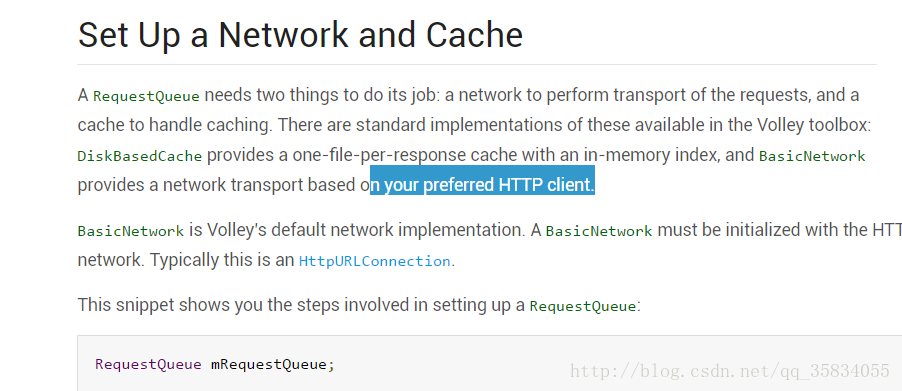
if (stack == null) {
if (Build.VERSION.SDK_INT >= 9) {
stack = new HurlStack();
} else {
// Prior to Gingerbread, HttpUrlConnection was unreliable.
// See: http://android-developers.blogspot.com/2011/09/androids-http-clients.html
stack = new HttpClientStack(AndroidHttpClient.newInstance(userAgent));
}
}
Network network = new BasicNetwork(stack);接著繼續看stack Volley內部做了個判斷 如果你的當前SDK版本大於9(2.3.3)則使用 HurlStack HttpURLConnection
如果小於2.3 則使用 HttpClientStack
原始碼中有個連結是 谷歌開發人員的一個部落格 介紹了利弊 
大概意思就是說在2.3以前用HttpClient最好 因為BUG少
2.3之後的HttpURLConnection 是最好的選擇 其簡單的API和程式碼量很少使其非常適合Android 透明的壓縮和快取快取減少網路使用,提高速度並節省電池
HttpClient都被google廢棄了 在6.0 SDK中直接拿掉了
接著又回到上頭 我們說過可以自定義Stack 選擇自己喜歡的http 但其實這個引數 一般都為空 …
倒序回到呼叫 
Stack 預設為null 
我們傳的是單引數的方法 傳到原始碼就是一個上下文 所以說還是會走系統預設 透過SDK自行選擇
mRequestQueue = Volley.newRequestQueue(this);
我們的volley 是透過一個 queue.start()方法開啟的 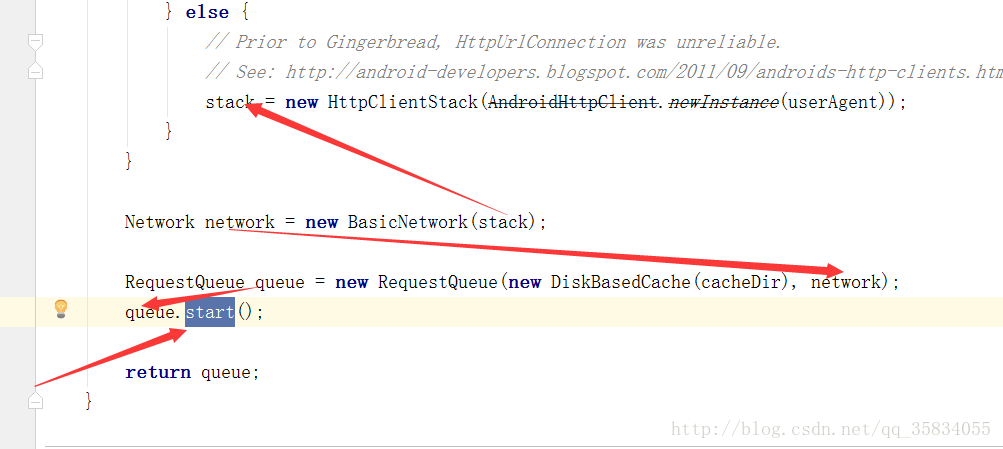
開啟
點進start 我們看到了這些程式碼
/**
* Starts the dispatchers in this queue.
*/
public void start() {
stop(); // Make sure any currently running dispatchers are stopped.
// Create the cache dispatcher and start it.
mCacheDispatcher = new CacheDispatcher(mCacheQueue, mNetworkQueue, mCache, mDelivery);
mCacheDispatcher.start();
// Create network dispatchers (and corresponding threads) up to the pool size.
for (int i = 0; i < mDispatchers.length; i++) {
NetworkDispatcher networkDispatcher = new NetworkDispatcher(mNetworkQueue, mNetwork,
mCache, mDelivery);
mDispatchers[i] = networkDispatcher;
networkDispatcher.start();
}
}我們看到了 在start前他先進行了stop 其實這是一種很好的程式碼實現方式
避免你這個應用被start兩次
接著建立快取排程程式並啟動它。
為什麼這麼說 new CacheDispatcher 快取執行緒 我們點進去看下
mCacheDispatcher = new CacheDispatcher(mCacheQueue, mNetworkQueue, mCache, mDelivery);
mCacheDispatcher.start();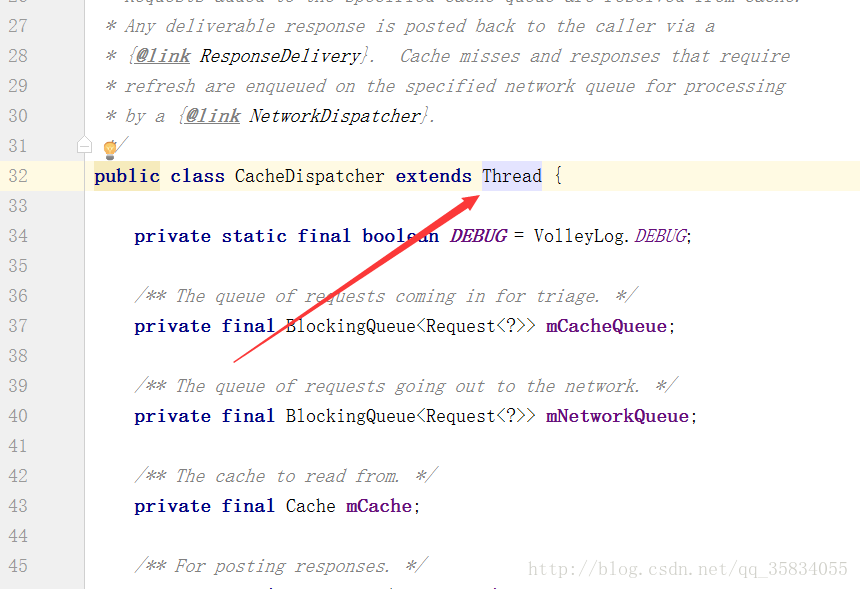
接著下面的程式碼 建立了一池子的網路執行緒
// Create network dispatchers (and corresponding threads) up to the pool size.
for (int i = 0; i < mDispatchers.length; i++) {
NetworkDispatcher networkDispatcher = new NetworkDispatcher(mNetworkQueue, mNetwork,
mCache, mDelivery);
mDispatchers[i] = networkDispatcher;
networkDispatcher.start();
}我們來找一找 for迴圈的length值為多少吧 點選mDispatchers
Shift+F 全域性查詢 
來到了這裡 threadPoolSize 是透過構造方法傳過來的
Alt+F7 檢視RequestQueue在哪裡被呼叫了

到了這 在快捷鍵 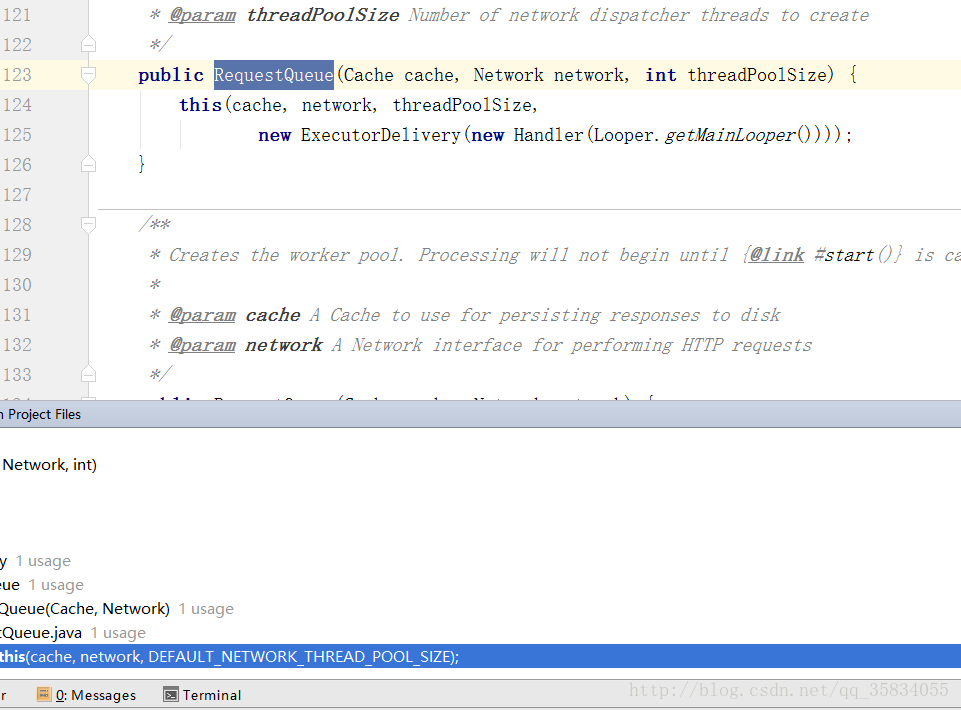
找到了呼叫地址 雙擊點進去 
上面可能有點花眼 重點記住快捷鍵的使用
也就是說當queue.start() 開啟的時候我們 建立了一個快取執行緒 並建立了
4個網路執行緒 並且分別把它們給開啟
12.30了 睡覺了 寫部落格真費時間…. 好在是週末
我們接著回到快取執行緒 CacheDispatcher繼承於 Thread 肯定會執行run方法 
我們來看看 快取執行緒的run方法都幹了些什麼
@Override
public void run() {
if (DEBUG) VolleyLog.v("start new dispatcher");
Process.setThreadPriority(Process.THREAD_PRIORITY_BACKGROUND);
// Make a blocking call to initialize the cache.
mCache.initialize();
while (true) {
try {
// Get a request from the cache triage queue, blocking until
// at least one is available.
final Request<?> request = mCacheQueue.take();
request.addMarker("cache-queue-take");
// If the request has been canceled, don't bother dispatching it.
if (request.isCanceled()) {
request.finish("cache-discard-canceled");
continue;
}
// Attempt to retrieve this item from cache.
Cache.Entry entry = mCache.get(request.getCacheKey());
if (entry == null) {
request.addMarker("cache-miss");
// Cache miss; send off to the network dispatcher.
mNetworkQueue.put(request);
continue;
}
// If it is completely expired, just send it to the network.
if (entry.isExpired()) {
request.addMarker("cache-hit-expired");
request.setCacheEntry(entry);
mNetworkQueue.put(request);
continue;
}
// We have a cache hit; parse its data for delivery back to the request.
request.addMarker("cache-hit");
Response<?> response = request.parseNetworkResponse(
new NetworkResponse(entry.data, entry.responseHeaders));
request.addMarker("cache-hit-parsed");
if (!entry.refreshNeeded()) {
// Completely unexpired cache hit. Just deliver the response.
mDelivery.postResponse(request, response);
} else {
// Soft-expired cache hit. We can deliver the cached response,
// but we need to also send the request to the network for
// refreshing.
request.addMarker("cache-hit-refresh-needed");
request.setCacheEntry(entry);
// Mark the response as intermediate.
response.intermediate = true;
// Post the intermediate response back to the user and have
// the delivery then forward the request along to the network.
mDelivery.postResponse(request, response, new Runnable() {
@Override
public void run() {
try {
mNetworkQueue.put(request);
} catch (InterruptedException e) {
// Not much we can do about this.
}
}
});
}
} catch (InterruptedException e) {
// We may have been interrupted because it was time to quit.
if (mQuit) {
return;
}
continue;
}
}
}我們看到 他維護了一個while true 的死迴圈
// Get a request from the cache triage queue, blocking until
// at least one is available.
final Request<?> request = mCacheQueue.take();
request.addMarker("cache-queue-take");從mCacheQueue 中拿到request
他這個死迴圈不是一直執行的而是一個阻塞式執行take()
如果有我就取 沒有就等著
// If the request has been canceled, don't bother dispatching it.
if (request.isCanceled()) {
request.finish("cache-discard-canceled");
continue;
}
他拿到了request 做了一個判斷你的request是不是被人給取消掉了 如果取消掉了就不做任何操作 如果沒有接著往下走
// Attempt to retrieve this item from cache.
Cache.Entry entry = mCache.get(request.getCacheKey());
if (entry == null) {
request.addMarker("cache-miss");
// Cache miss; send off to the network dispatcher.
mNetworkQueue.put(request);
continue;
}透過 request.getCacheKey() 嘗試從快取的集合中拿到他快取的資料
getCacheKey getUrl 透過這個url伺服器地址為一個key 進行判斷
/**
* Returns the cache key for this request. By default, this is the URL.
*/
public String getCacheKey() {
return getUrl();
}如果沒有request快取資料 就把這個request新增到網路佇列裡
mNetworkQueue.put(request);如果有快取資料則不會走之前的if判斷 就走到了這裡
// If it is completely expired, just send it to the network.
if (entry.isExpired()) {
request.addMarker("cache-hit-expired");
request.setCacheEntry(entry);
mNetworkQueue.put(request);
continue;
}entry.isExpired() 判斷你快取資料是否過期了 如果過期
接這把你新增到網路對列裡 mNetworkQueue.put(request); 等待網路請求
如果有快取並且沒有過期就接著往下走
Response<?> response = request.parseNetworkResponse(
new NetworkResponse(entry.data, entry.responseHeaders));解析與響應 他把你快取的資料存進去 並最終拿到了response 想要的資料
Volley可以把原生的響應資料 entry.data 解析成你想要的資料 也就是io流帶過來的二進位制
接著繼續走到了這句
mDelivery.postResponse(request, response);把request響應的資料分發到主執行緒 這就是快取大概流程
接著我們看網路執行緒的run方法 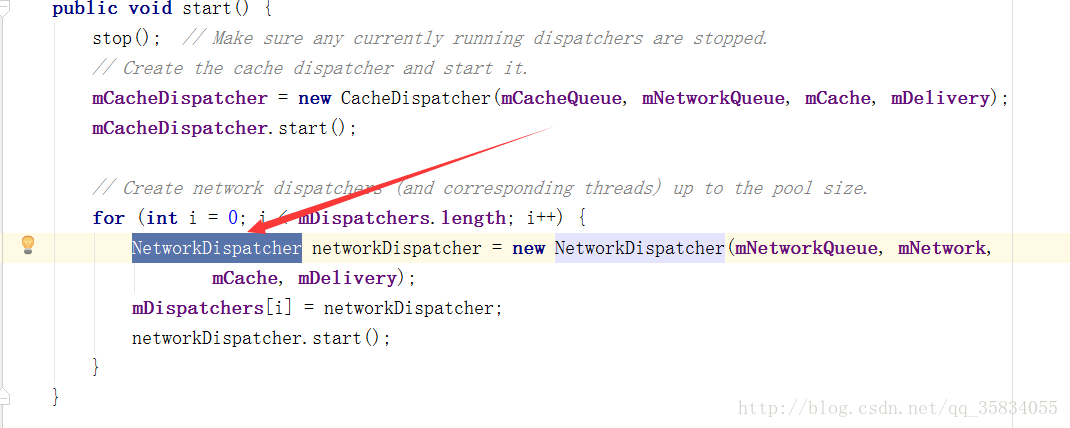
網路執行緒的run方法
@Override
public void run() {
Process.setThreadPriority(Process.THREAD_PRIORITY_BACKGROUND);
while (true) {
long startTimeMs = SystemClock.elapsedRealtime();
Request<?> request;
try {
// Take a request from the queue.
request = mQueue.take();
} catch (InterruptedException e) {
// We may have been interrupted because it was time to quit.
if (mQuit) {
return;
}
continue;
}
try {
request.addMarker("network-queue-take");
// If the request was cancelled already, do not perform the
// network request.
if (request.isCanceled()) {
request.finish("network-discard-cancelled");
continue;
}
addTrafficStatsTag(request);
// Perform the network request.
NetworkResponse networkResponse = mNetwork.performRequest(request);
request.addMarker("network-http-complete");
// If the server returned 304 AND we delivered a response already,
// we're done -- don't deliver a second identical response.
if (networkResponse.notModified && request.hasHadResponseDelivered()) {
request.finish("not-modified");
continue;
}
// Parse the response here on the worker thread.
Response<?> response = request.parseNetworkResponse(networkResponse);
request.addMarker("network-parse-complete");
// Write to cache if applicable.
// TODO: Only update cache metadata instead of entire record for 304s.
if (request.shouldCache() && response.cacheEntry != null) {
mCache.put(request.getCacheKey(), response.cacheEntry);
request.addMarker("network-cache-written");
}
// Post the response back.
request.markDelivered();
mDelivery.postResponse(request, response);
} catch (VolleyError volleyError) {
volleyError.setNetworkTimeMs(SystemClock.elapsedRealtime() - startTimeMs);
parseAndDeliverNetworkError(request, volleyError);
} catch (Exception e) {
VolleyLog.e(e, "Unhandled exception %s", e.toString());
VolleyError volleyError = new VolleyError(e);
volleyError.setNetworkTimeMs(SystemClock.elapsedRealtime() - startTimeMs);
mDelivery.postError(request, volleyError);
}
}
}首先看到的依舊是一個 阻塞 死迴圈 依舊是從一個mQueue取request
// Take a request from the queue.
request = mQueue.take();也做了一個判斷 取消了不做任何操作
if (request.isCanceled()) {
request.finish("network-discard-cancelled");
continue;
}沒取消就走到了這裡 去執行一個網路請求 拿到了networkResponse
// Perform the network request.
NetworkResponse networkResponse = mNetwork.performRequest(request);
request.addMarker("network-http-complete");如果沒有304異常就把networkResponse 解析成了一個response
// Parse the response here on the worker thread.
Response<?> response = request.parseNetworkResponse(networkResponse);
request.addMarker("network-parse-complete");接著走到了一個判斷
// Write to cache if applicable.
// TODO: Only update cache metadata instead of entire record for 304s.
if (request.shouldCache() && response.cacheEntry != null) {
mCache.put(request.getCacheKey(), response.cacheEntry);
request.addMarker("network-cache-written");
}如果我的請求是被需要快取的request.shouldCache() 那就寫快取
mCache.put(request.getCacheKey(), response.cacheEntry);
寫完了快取就走到了這裡 分發到主執行緒
mDelivery.postResponse(request, response);我們來看看postResponse怎麼傳送到主執行緒的把 
我們來到了這裡 正常的執行緒池execute 裡面應該是開執行緒 處理事件 Volley重寫了這個方法 直接分發到主執行緒
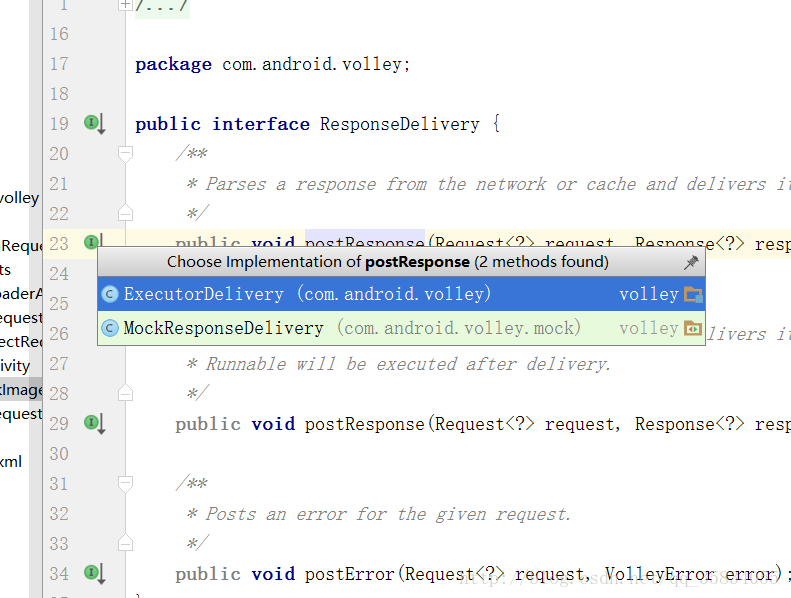
因此,我們的Response響應最終會在主執行緒被呼叫方接收並進行處理。
總結圖片

Volley只是個框架從原始碼就能看到 最底層的操作還是由 HttpClient HttpURLConnection 來實現的 其實選擇網路可以改成okhttp 可自行改造 自由度非常高
最後我感覺我寫的挺清晰了 有什麼不對的地方 希望留言 我會進行修改 詳細到寫的我快吐血了….
相關文章
- Volley原始碼分析(二)2017-08-22原始碼
- Android Volley原始碼分析2015-08-26Android原始碼
- Architecture(2)Volley原始碼分析2019-03-04原始碼
- Volley 原始碼探索2018-11-06原始碼
- Android Volley的優缺點及原始碼分析2017-05-10Android原始碼
- Volley原始碼分析【面向介面程式設計的典範】2016-06-03原始碼程式設計
- 2017-10-9(Volley使用範例原始碼分析)2017-12-13原始碼
- 遲到的Volley原始碼解析2017-04-28原始碼
- Android Volley框架原始碼解析2018-01-08Android框架原始碼
- Google Volley框架原始碼走讀2015-06-11Go框架原始碼
- Volley 原始碼解析之圖片請求2018-12-29原始碼
- Volley 原始碼解析之快取機制2019-01-06原始碼快取
- Volley 原始碼解析之網路請求2018-12-21原始碼
- Android 開源專案原始碼解析 -->Volley 原始碼解析(十五)2016-09-27Android原始碼
- Android Volley 原始碼解析(二),探究快取機制2018-02-12Android原始碼快取
- Retrofit原始碼分析三 原始碼分析2018-05-17原始碼
- 集合原始碼分析[2]-AbstractList 原始碼分析2019-04-11原始碼
- 集合原始碼分析[1]-Collection 原始碼分析2019-03-23原始碼
- 集合原始碼分析[3]-ArrayList 原始碼分析2019-04-12原始碼
- Guava 原始碼分析之 EventBus 原始碼分析2018-08-01Guava原始碼
- Android網路程式設計(四)從原始碼解析Volley2016-07-31Android程式設計原始碼
- Android 原始碼分析之 AsyncTask 原始碼分析2019-03-04Android原始碼
- 【JDK原始碼分析系列】ArrayBlockingQueue原始碼分析2020-09-27JDK原始碼BloC
- 以太坊原始碼分析(36)ethdb原始碼分析2018-05-14原始碼
- 以太坊原始碼分析(38)event原始碼分析2018-05-14原始碼
- 以太坊原始碼分析(41)hashimoto原始碼分析2018-05-14原始碼
- 以太坊原始碼分析(43)node原始碼分析2018-05-14原始碼
- 以太坊原始碼分析(52)trie原始碼分析2018-05-14原始碼
- Android Volley 原始碼解析(三),圖片載入的實現2018-02-24Android原始碼
- 深度 Mybatis 3 原始碼分析(一)SqlSessionFactoryBuilder原始碼分析2019-06-06MyBatis原始碼SQLSessionUI
- 以太坊原始碼分析(51)rpc原始碼分析2018-05-14原始碼RPC
- 【Android原始碼】Fragment 原始碼分析2017-12-23Android原始碼Fragment
- 【Android原始碼】Intent 原始碼分析2017-12-23Android原始碼Intent
- Android Volley 原始碼解析(一),網路請求的執行流程2018-02-11Android原始碼
- k8s client-go原始碼分析 informer原始碼分析(6)-Indexer原始碼分析2022-06-19K8SclientGo原始碼ORMIndex
- k8s client-go原始碼分析 informer原始碼分析(4)-DeltaFIFO原始碼分析2022-05-22K8SclientGo原始碼ORM
- 以太坊原始碼分析(20)core-bloombits原始碼分析2018-05-14原始碼OOM
- 以太坊原始碼分析(24)core-state原始碼分析2018-05-14原始碼